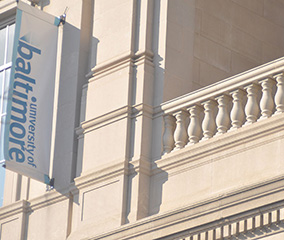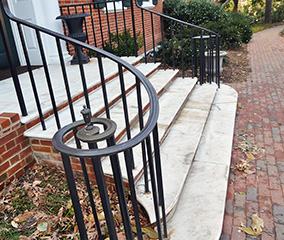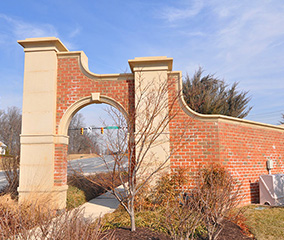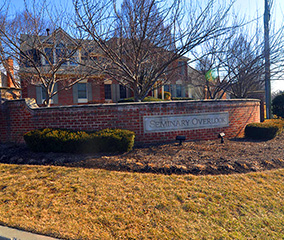Using bricks for outdoor projects is exceptionally popular. Bricks are sturdy, lovely, and remain one of the best ways to construct a wide variety of structures. So, as you think about your next masonry project, you may want to consider incorporating bricks into your design. Let’s check out some reasons why bricks are awesome. (more…)
Archive for the ‘ Brick ’ Category
The Rundown on Bricks
Sunday, May 3rd, 2015Rid Your Outdoor Bricks of Moss
Sunday, April 12th, 2015Something about the humidity of spring brings with it the threat of moss planting itself on your beautiful bricks. Moisture brings moss, so if your bricks are in a place where there is a lot of shade and moisture, then you should check on them. Moss likes to grow in a variety of places as long as they are stationary, but don’t worry. You can get rid of this nuisance of moss so that your bricks can go back to looking clean and fresh. Let’s check it out. (more…)
How Masonry Can Improve the Value of your Property
Monday, February 23rd, 2015 It is exciting to complete a home renovation project. When you take a look at your beautiful new kitchen complete with granite countertops and a shiny new built-in wine cooler, you think, “What’s next?” The inside transformation will most definitely increase the value of your home, but many forget to remember that the outside is what draws consumers in. Pulling up to the front of your home gives a potential buyer his or her first impression of the home. “It’s great, but…” is a common phrase when something is off in a buyer’s mind. You want top dollar for your property so making sure the outside matches the inside is crucial to increase the property value.
It is exciting to complete a home renovation project. When you take a look at your beautiful new kitchen complete with granite countertops and a shiny new built-in wine cooler, you think, “What’s next?” The inside transformation will most definitely increase the value of your home, but many forget to remember that the outside is what draws consumers in. Pulling up to the front of your home gives a potential buyer his or her first impression of the home. “It’s great, but…” is a common phrase when something is off in a buyer’s mind. You want top dollar for your property so making sure the outside matches the inside is crucial to increase the property value.
Generate curb appeal.
Giving your home curb appeal will escalate its property value. A manicured lawn, a custom stone sidewalk and a smoothly paved asphalt driveway are all factors that contribute to curb appeal. Repointing your chimney is also a good way to give your home the “oomph” factor it needs. If your chimney looks like it is not supposed to be attached to your house, it may be time to have it re-done.
Upscale your home with brick.
Using brick to add property value is very common and is a mason’s job. Residing your home with brick not only increases its appearance but makes it more energy efficient. Brick and stonework have become more popular among new homebuyers. The more people want houses like this, the higher the price of the home. It is a smart choice to add stonework to your front and back yards.
Create ambiance with stonework in the backyard.
Having a patio for guests and family to sit on is wonderful during the spring, summer, and fall months. It allows for more space to entertain. Friends will be impressed with a stone patio complete with an outdoor fireplace. This air of elegance increases the property value significantly. The higher the quality of materials is, the higher the price of your home will be.
Want a Reliable Maryland Masonry Contractor?
Call Delprete Masonry. As Maryland’s foremost experts on masonry repair, construction, and demolition, our skilled teams have what it takes to provide you with the very best in masonry contracting. At Del Prete Masonry, we’ve got the answers you’re looking for.
To find out more about your masonry repair options, please contact our office today at 410-683-0650 or email us at mike@delpretemasonry.com. We serve Baltimore City, County, Harford County, Carroll County, Anne Arundel County, and Howard County. Keep up with our blog for masonry related information, and follow us on Facebook, Twitter, and Google+.
Building Better with Brick
Monday, February 2nd, 2015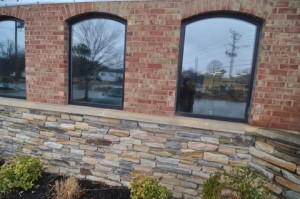 Spring is coming, your tax returns are around the corner, and you’re planning a new home improvement project. Del Prete Masonry is here to help, and to lead off we’ll explain why brick is the best material for your new home improvement project.
Spring is coming, your tax returns are around the corner, and you’re planning a new home improvement project. Del Prete Masonry is here to help, and to lead off we’ll explain why brick is the best material for your new home improvement project.
Strong and Safe
Fired brick, or ceramic brick, has been in use for thousands of years as a strong, long lasting material, durable to the elements. The component elements of brick can be altered to change its attributes, for example, brick can be made lighter, or stronger depending on the mixture. The raw materials and temperature that bricks are fired at can also be used to change the temperature of the bricks. Brick does not warp, rot, or erode as other construction materials might. It is also fireproof, and brick masonry has been shown to reduce the chances of a home being destroyed by a fire.
Low Maintenance and Energy Efficient
Brick is requires little maintenance, and has a high thermal mass, both aspects which make it an energy efficient building material.
Brick masonry construction does not need to be repainted, sanded, or refinished, like painted wood or plaster, and it does not fade and need to be replaced like vinyl siding does. All the maintenance brick needs is an occasional cleaning. This saves you time, energy, and money.
Brick’s thermal mass also makes it energy efficient. The thermal mass of a material measures how a material absorbs and releases heat. Another way to put it would be as a measurement of the thermal “inertia” of a material. Materials like iron are good thermal conductors and have a low thermal mass, it absorbs and releases heat quickly. Brick acts as a material with a high thermal mass, and has a high thermal inertia. Brick keeps the house cool during the day, slowly absorbing and storing heat from the surrounding air and sun. When night comes time and the outside temperature starts to cool, the brick releases the heat it has absorbed into the home, and then starts the process all over again with dawn. Materials with a high thermal mass, like brick, are best in temperate climates like where we are.
Aesthetically Flexible
As a design material, fired brick is one of the most flexible materials around. Brick come in many colors, from whites and yellows, to the more common pinks, reds, and browns. Brick may even be purple or black. Bricks can be made to all be the same color, or you can alternate colors, and construction patterns to make designs in whatever you’re constructing. It can be used in classical as well as contemporary design. And brick can be used well with other materials as a complementary or contrasting feature.
Want your next Home Improvement project done with Brick?
Call Del Prete Masonry. As Maryland’s foremost experts on masonry repair, construction, and demolition, our skilled teams have what it takes to provide you with the very best in masonry contracting. At Del Prete Masonry, we’ve got the answers you’re looking for.
To find out more about your masonry repair options, please contact our office today at 410-683-0650 or email us at mike@delpretemasonry.com. We serve Baltimore City, County, Harford County, Carroll County, Anne Arundel County, and Howard County. Keep up with our blog for masonry related information, and follow us on Facebook, Twitter, and Google+.
The History of Brick
Friday, January 16th, 2015At Del Prete Masonry, we’re proud to continue the historic tradition of masonry, a craft that extends thousands of years into our past, with a history as storied and fascinating as the chronicle of any nation. Today, we’re looking backwards into the history behind one of the most crucial and powerful items of our trade: the humble brick.
The Middle East
As far as historians can tell, the earliest discovered bricks date as far back as 7500 BC. These early bricks were dried, which means that they were made out of clay-laden dirt and mud, then dried under sunlight until they were hearty enough to be used in construction. The oldest known bricks hail from a part of the planet that is now Syria. Other discoveries, which date as far back as 7000 BC, include bricks from the ancient city of Jericho and the Egyptian fortress of Buhen which ran along the west bank of the Nile River.
China
As early as 2000 BC, bricks were certainly being used in Chinese architecture. Scientists and scholars have even established that the Chinese were already mass-producing bricks roughly 300 years ago during the Western Zhou dynasty. In 1368 AD, under the Ming Dynasty, bricks were already being fired in kilns. To make these bricks clay and water were mixed together, then trampled over by oxen who beat it into a paste. The paste was then lain in wood frames and smoothed with a wiry bow. The bricks were then stamped with the brickmaster’s insignia and loaded into a wood-fueled kiln and removed while the kiln was still burning.
Europe
The Ancient Greek and Roman civilizations also used fired bricks. The Romans designed and perfected the use of mobile, cart-bound kilns and constructed massive brick buildings and structures all over their empire bearing the seal of the Roman legion. The middle ages saw brickmaking finally make its way to northern Europe and was popular in places without native rocks suitable for construction. Some of these buildings still stand today in Denmark, Germany, Russia, and Poland. This kind of brickmaking and architecture would eventually transform into the style that became popularized during the Italian Renaissance.
At Del Prete, We Know Where We’re Coming From
We recognize the importance of history and our professionals know everything about brick masonry, from practical skills to historical facts. For other questions regarding brick masonry, feel free to contact Delprete Mansonry. Our brick masonry professionals have the experience and history of satisfied clients to prove that we’ll get the job done right, and cost-effectively. To get started with your brick masonry project, please contact our office today at 410-683-0650 or email us at mike@delpretemasonry.com. We serve Baltimore City, County, Harford County, Carroll County, Anne Arundel County, and Howard County.
Keep up with our blog for masonry related information, and follow us on Facebook, Twitter, and Google+.
Caring for your Brick Masonry Structure
Monday, September 22nd, 2014One of the most popular building materials for centuries, brick masonry is used from everything from stately colonial mansions or small country cottages, to dignified commercial structures. Its versatility, efficiency, and appearance all contribute to raising the property and aesthetic value of your home. While generally maintenance free, it’s still important to take care of your brick structures to assure that your commercial masonry investment is protected and their longevity is being leveraged to its maximum potential.
Cleaning
Once a year, be sure to go over your brick masonry with a hose, equipped with a spray nozzle, to remove any loose dirt. Also if any side of your brick masonry structure or house gets very little sunlight you should be on the lookout for moss, mold, or mildew growth. Scrubbing any affected areas with a solution of 1cup of bleach to 1 gallon of water will clean most of this up. Avoid using wire brushes that can scratch or damage brick and be sure to rinse these areas with water BEFORE applying the bleach solution.
Check for Water Damage
Water damage to brick masonry has two potential causes: Splash back and rising damp. Splash back is the process by which rain, over a long period of time, is slowly absorbed into brick causing the mortar or brick itself to crack. Rising damp occurs when ground water seeps upwards, leaving behind what is known as a “tide line”. This line will disappear but will cause a buildup of salt crystals that will ultimately break down brick and mortar. Check for water damage routinely and allocate funds for repointing every 5-10 years.
Repointing
Repointing is the process of renewing the external parts of mortar joints, which hold brick masonry structures together. If you find signs of damaged mortar, consider having it repointed. This involves careful removal of the existing mortar, and a fresh application of a new batch. When repointing, the depth of the new mortar should be approximately twice the width of the existing mortar joints.
If you own an older house and want to preserve visual integrity, make sure that your fresh mortar matches the original. A contractor can take a sample of existing mortar and dissolve it in acid, exposing the base sand aggregate used to manufacture it, so that it can be replicated.
Get Help from Del Prete Masonry
Brick is a great foundation for any building, and as commercial masons, we can fully appreciate the benefits of brick. If you need your commercial masonry repaired, please contact our office today at 410-683-0650 or email us at mike@delpretemasonry.com. We serve Baltimore City, County, Harford County, Carroll County, Anne Arundel County, and Howard County. Keep up with our blog for masonry related information, and follow us on Facebook, Twitter, and Google+.
Source: bobvilia.com






